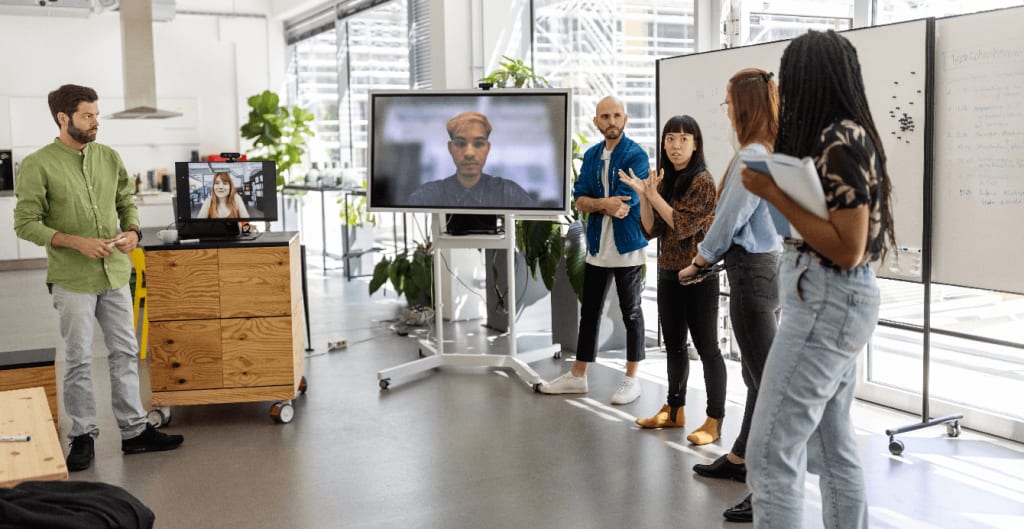
7 tech solutions corporate leaders can use to make sense of return-to-office
The summer of 2023 ushered in the next chapter of the return-to-office saga. Dozens of the nation’s largest companies began transitioning remote workers back into physical workspaces.
With new expectations from corporate leadership around the three-day, in-person work week becoming more widespread, expressions of employee resistance and questions about the benefits of packing up remote workstations are becoming more common.
CEOs from various organizations have already responded through internal memos and interviews, centering their statements around several common themes. The top pitches for being in the office revolve around personal connection, better collaboration, and spontaneous creativity.
But how can your leadership communicate their vision and help employees comprehend the latest iteration of the return-to-office? The key lies in deploying the right technology solutions to enhance and streamline how employees connect with each other when they are in the office.
"We are losing the art of collaboration, doing so much of our work in silos prevents actual prioritization, and we are having a hard time operationalizing decisions quickly and thoughtfully."
Howard SchultzInterim CEO of Starbucks
1. Integrated Workplace Management Systems (IWMS)
Collaboration and operational efficiency are critical drivers of success in your workplace. When properly optimized, Integrated Workplace Management Systems (IWMS) provide organizations with comprehensive capabilities to streamline operations and enhance collaboration. By leveraging or upgrading their existing IWMS solution, executives can optimize space utilization, improve communication between employees, and make informed decisions more quickly.
2. Digital workplace platforms
Digital workplace platforms further enhance employee collaboration by providing real-time communication, document sharing, task management, and workflow automation. These platforms empower employees to collaborate effectively regardless of their physical location, ensuring seamless teamwork, streamlined workflows, and efficient decision-making processes, regardless of the number of days employees are in the office.
"In a creative business like ours, nothing can replace the ability to connect, observe, and create with peers that comes from being physically together, nor the opportunity to grow professionally by learning from leaders and mentors."
Bob IgerCEO of Walt Disney Co.
3. Workplace analytics solutions
To foster creativity, peer connections, and professional growth in your workplace, optimization technologies will play a crucial role. Workplace analytics solutions collect data on space utilization and employee behaviors, helping your organization to design office environments that facilitate collaboration, innovation, and organic interactions.
This includes designating dedicated spaces for brainstorming sessions, common areas for spontaneous discussions, and quiet areas for focused work.
4. Workplace experience apps
Workplace experience apps enhance the in-person experience by facilitating event scheduling, enabling employee engagement, and providing access to resources and amenities.
These apps also ensure that your employees can connect and learn from peers and mentors consistently. When the office is associated with opportunities for learning and professional growth, employees will be more enthusiastic about in-person work.
"Screens deny us the subtleties of body language and the nuances of knowing glances. The spontaneity and serendipity of a dynamic office environment are crucial in creating and in iterating, so in-office attendance is vital to our future success."
Robert ThomsonCEO of News Corp
5. Digital wayfinding solutions
The in-person experience won’t have much of an impact if your employees feel disconnected. Digital wayfinding apps enhance the in-office experience by making it easy for your employees to find their favorite collaborators.
For employees returning to the office after a long period (or for those who have never been to a physical location), digital wayfinding apps assist employees in navigating office spaces, finding available meeting rooms, and locating colleagues. These apps foster additional spontaneous connections between employees and enhance the dynamic of an office environment.
Executives can leverage these apps to encourage in-person attendance, enabling creative collaborations, iterative processes, and the building of professional relationships.
"Uneven and inconsistent adoption of the return-to-office mandate had made it difficult to realize the benefits of in-person learning, collaboration, and connection."
Vanguard Group6. Space reservation systems
Consistency is essential for a successful return to the office. Space reservation systems and health and safety monitoring solutions help ensure consistent adoption of return-to-office mandates while creating a safe and productive work environment.
Space reservation systems enable employees to book desks or meeting rooms in advance, ensuring efficient space utilization and adherence to capacity limits. Safety technologies, such as occupancy sensors and touchless entry systems, support health compliance via real-time data on space occupancy, enabling leadership to guarantee a consistent and safe return to the office.
"You can't delegate digital transformation for your company. You and your executives have to own it! Executives need to engage, embrace, and adopt new ways of working with the latest and emerging technologies."
Barry RossCEO and Co-Founder, Ross & Ross International
7. Digital transformation strategy
Your organization needs a detailed strategy to ensure employees can effectively collaborate, innovate, and navigate the return-to-office as they embrace a digital-first environment. This is an opportunity for executives to champion technology adoption and drive digital transformation initiatives.
Examples include leveraging digital workplace solutions, change management support, and training programs to engage employees and optimize the usage of the latest technologies. Digital workplace solutions that can support this effort include communication platforms, project management software, and document collaboration tools. Leadership can actively engage their teams, encourage adoption, and facilitate training programs.
Next steps for corporate leadership
To keep their promises around the next phase of the return to office, corporate leaders must prioritize creating a collaborative, engaging, and efficient workplace environment. This is a path that JLL Technologies helps organizations like yours navigate every day.
Connect with our IWMS, workplace, analytics, and technology solutions experts today to learn how we can help make the latest version of the workplace the best version. Check out this report to learn why Verdantix ranked us as a market leader among workplace systems integrators.
This blog post was created with assistance from generative AI.